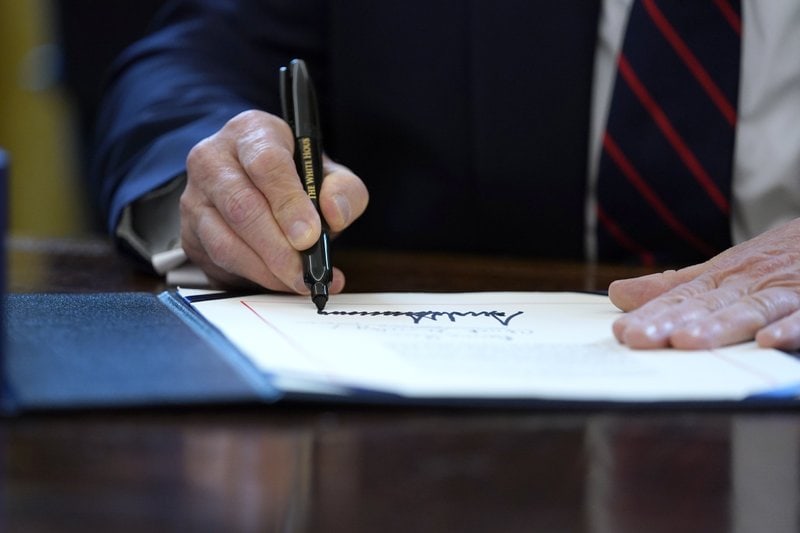
WASHINGTON (AP) — Highlights of a $2.2 trillion package to help businesses, workers and a health care system staggered by the coronavirus that President Donald Trump signed into law Friday after the House voted final congressional approval.
— Loans and guarantees to businesses, state and local governments: $500 billion. Up to $50 billion for passenger airlines and $8 billion for air cargo carriers, half for paying workers. $17 billion for “businesses critical to maintaining national security.” Borrowers must be U.S.-based. Cannot repurchase outstanding stock or pay dividends until one year after borrowing is repaid, or give raises to executives earning over $425,000 annually. Must maintain employment levels of March 24, 2020, “to the extent practicable” through Sept. 30, and not cut jobs by over 10% from that level. Ineligible for loans if top Trump administration officials, members of Congress or their families have 20% control.
— Small businesses: Includes $350 billion in loans up to $10 million each for companies with 500 employees or fewer. Portion of loans can be forgiven if employers retain workers. Includes nonprofits, self-employed people and hotel and restaurant chains with up to 500 workers per location. Also $17 billion to help small businesses repay existing loans; $10 billion in grants for small businesses’ operating costs.
— Emergency unemployment insurance: $260 billion. Weekly benefit increase of $600 for four months. Extra 13 weeks of coverage for people who have exhausted existing benefits. Also covers part-time, self-employed, gig economy workers.
— Health care: $150 billion. Includes $100 billion for grants to hospitals, public and nonprofit health organizations and Medicare and Medicaid suppliers. To spur production of needed products, gives liability protection to makers of devices like respirators. Some restrictions waived to make tele-health more accessible.
— State and local governments: $150 billion, at least $1.25 billion for smallest states.
— Direct payments to people: One-time payments of $1,200 per adult, $2,400 per couple, $500 per child. Amounts begin phasing out at $75,000 for individuals, $150,000 per couple.
— Tax breaks: Temporarily waives penalties for virus-related early withdrawals from some retirement accounts, eases required minimum annual disbursements from those accounts. Increases deductions for charitable contributions. Employers who pay furloughed workers can get tax credits for some of those payments. Postpones business payments of payroll taxes until 2021 or 2022.
— Department of Homeland Security: $45 billion for disaster relief fund to reimburse state and local governments for medical response, community services. Extends federal deadline for people getting driver’s licenses with enhanced security features, called REAL ID, from Oct. 1, 2020, to Sept. 30, 2021.
— Education: $31 billion. Includes money for local school systems, higher education.
— Coronavirus: $27 billion for development of vaccines and for treatments, stockpiling medical supplies.
— Transportation: Includes $25 billion for public transit systems; $10 billion for publicly owned commercial airports, $1 billion for Amtrak.
— Veterans: $20 billion, including funds for treating veterans at VA facilities and creating temporary and mobile facilities.
— Food and agriculture: $15.5 billion for food stamps; $14 billion for supporting farm income and crop prices; $8.8 billion for child nutrition. Also money for specialty crops, livestock, food banks, farmers’ markets.
— Defense: $10.5 billion, including $1.5 billion to nearly triple the 4,300 beds currently in military hospitals. Funds for states to deploy up to 20,000 members of National Guard for six months. Money cannot be used to build Trump’s proposed wall along Mexican border.
— Social programs: $3.5 billion for child care and early education programs; $1 billion to help communities address local economic problems. Extra money for heating, cooling aid for low-income families and Head Start.
— Communities: $5 billion in grants to help state and local governments expand health facilities, child care centers, food banks and senior services. Extra money for programs for homeless people, low-income renters and for communities to rebuild local industries including tourism and fishing.
— Native American communities: $2 billion for health care, schools,
— Diplomacy: $1.1 billion, including $324 million to evacuate Americans and diplomats overseas. Also funds to help refugees, international disaster efforts aid.
— Elections: $400 million to help states prepare for 2020 elections with steps including expanded vote by mail, additional polling locations.
— Arts: $150 million for federal grants to state and local arts and humanities programs; $75 million for Corporation for Public Broadcasting; $25 million for Washington, D.C., Kennedy Center for the Performing Arts.
— Congress: $93 million, including $25 million for the House and $10 million for the smaller Senate for teleworking and other costs; $25 million for cleaning the Capitol and congressional office buildings.
___
Sources: Legislative text, summaries from Senate Republicans and Democrats.


